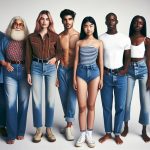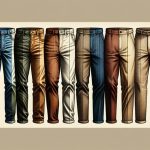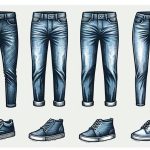So, I've been thinking, is denim the same as jeans, or have we all been mixing things up? You see, denim's that tough fabric we all love, known for its durability and that classic diagonal weave. Then there are jeans, those go-to pieces in our wardrobe made from denim. It's like saying all squares are rectangles but not all rectangles are squares, right? But here's the kicker, there's more to this story than just fabric and fashion items. Stick around, and let's unravel this mystery together. Why? Because understanding the distinction could change how you look at your favorite pair of jeans.
Table of Contents
Key Takeaways
- Denim is a cotton twill fabric used to make jeans, among other items.
- Jeans refer to the actual garment made from denim fabric.
- While all jeans are made of denim, not all denim is used for jeans.
- Denim's unique characteristics, like its diagonal ribbing, are what make jeans durable and distinctive.
- The term "jeans" specifically denotes the style of pants, whereas "denim" refers to the material they are made from.
Understanding Denim
To really get why jeans are so popular, it's key to dig into what denim's all about. This fabric is more than just a trend; it's a durable cotton twill textile that's been around since Levi Strauss made it famous. When we talk about denim, we're diving deep into a world of cotton crafted in a specific way – with diagonal ribbing that not only adds to its unique texture but also its strength. Now, denim isn't just any cotton fabric; it's got its own personality, thanks to this twill weaving that sets it apart from other materials.
Denim's journey from the workwear of the French to a global fashion icon is nothing short of remarkable. It's this evolution that highlights the difference between denim and jeans. While denim refers to the fabric itself, jeans are the actual clothing item made from this material. So, when you slip into a pair of jeans, you're wearing a piece of fashion history that's built to last. Denim can come in various weights and finishes, offering a range of styles that go beyond the classic pair of jeans.
Defining Jeans
Jeans, those durable pants we all love, are essentially made from denim, a tough cotton fabric that's built to last. It's this sturdy construction from denim, or cotton twill, that gives jeans their reputation for durability. Over the years, they've evolved from a practical choice for miners and cowboys into a fashion staple that's found in nearly everyone's wardrobe.
What makes jeans stand out isn't just their material but also their versatility. They come in a variety of styles and fits, catering to different preferences and body types. Here's a quick rundown:
- Durability: Jeans are known for their sturdy construction, making them a long-lasting garment choice.
- Versatile Fashion Staple: They've become an indispensable part of our fashion, fitting in seamlessly with almost any outfit.
- Variety of Styles: From skinny to boot cut, there's a pair of jeans out there for everyone, reflecting how adaptable denim as a fabric truly is.
In a nutshell, jeans are much more than just a piece of clothing; they're a versatile, durable garment that's become a cornerstone of modern fashion. Their sturdy construction from denim ensures they're not just a temporary trend but a lasting wardrobe essential.
Fabric Composition and Weave
Diving into the fabric composition and weave of denim, it's primarily made from 100% cotton, creating that durable and iconic material we all know. This cotton fabric is crafted using a twill weave, which gives denim its unique look and feel.
Now, when we talk about jeans, they often mix things up a bit by including blends of cotton and elastane. This addition of elastane is what brings in that much-appreciated stretch, making your jeans not just stylish but super comfortable too.
The twill weave isn't just for show; it's what gives denim fabric its diagonal ribbing. This ribbing isn't just a design element; it contributes to the fabric's durability and long-lasting wear. And then there's the indigo dye, the hero behind denim's iconic blue hue. It's this specific dyeing process that turns the cotton fabric into the denim we can't seem to get enough of.
Care and Maintenance
Caring for your denim properly can dramatically extend its life and keep those favorite jeans looking good as new. When it comes to denim fabric, understanding and following the right care instructions is key. I've learned that washing jeans infrequently is crucial to maintain their color and quality. Here's what else I do to keep my jeans in top shape:
- Wash with complementary colors: This prevents color transfer, especially important for dark jeans which could otherwise dye lighter clothing.
- Hang drying: I always hang dry my jeans to avoid any shape loss and to increase longevity. It also helps in maintaining the fabric integrity.
- Medium heat setting for drying: When I can't hang dry and have to use a dryer, I make sure it's on a medium heat setting. This is a good compromise to prevent shrinking and keep the jeans looking their best.
Washing them on a medium cycle in cold water has also been a game-changer for shrinking prevention. By taking these steps, I've noticed my jeans not only last longer but also retain their original look and feel, making every effort worth it.
Cultural Evolution and Trends
From workwear to fashion icons, denim's journey through the years has made it a key player in shaping cultural trends. I've seen how denim and jeans have evolved, reflecting changes in society and fashion. Initially, jeans were the go-to for tough, manual work due to their durability. But boy, how things have changed.
| Era | Significance |
|---|---|
| 1950s | Jeans as rebellion symbol |
| 20th Century Surge | Transition to fashion statement |
| Mid-20th Century | Symbol of youth and counterculture |
| Timeless Fashion | Reflecting societal shifts |
| Global Phenomenon | From workwear to high fashion |
Jeans transitioned from being merely functional to a symbol of rebellion, especially among the youth in the 1950s. It's fascinating how a piece of clothing can become an emblem of counterculture movements, isn't it? Through time, both denim and jeans have become fashion staples, adapting to and reflecting the evolving style preferences of generations. They're not just clothes; they're a statement, a piece of history, and frankly, they're timeless. It's clear to me that the cultural evolution of denim isn't just about fashion trends; it's about making a statement, being part of a movement, or simply embracing a timeless piece of comfort and style.
Frequently Asked Questions
What Is the Difference Between Denim and Regular Jeans?
I've learned that the main difference is denim's a fabric, while regular jeans are pants made from this material. Jeans often mix in elastane for stretch, but denim's usually just cotton. Pretty straightforward, right?
Are Jeans Called Denim?
I've noticed people often call jeans "denim" because they're made from denim fabric. But technically, denim's the material, and jeans are the pants. This mix-up shows how closely they're related in our minds.
What Is the Difference Between Denim and Non Denim Jeans?
I've learned that the difference lies in the material. Denim jeans are made from cotton twill, while non-denim jeans use other fabrics like corduroy or velvet, offering various textures and styles.
What Is the Difference Between Pants and Denim?
I've discovered that the main difference between pants and denim lies in their definition. Pants are any bottom-wear, while denim's that tough fabric used specifically for making jeans. It's all about the material, really.
- How Does Ring Spun Cotton Affect Garment Fit and Shape Retention? - August 13, 2024
- What Are the Challenges in Producing Ring Spun Cotton? - August 13, 2024
- Is Ring Spun Cotton Suitable for Plus-Size Clothing? - August 13, 2024






